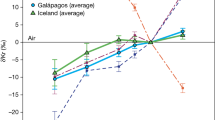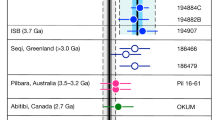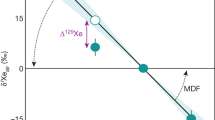Abstract
Helium is used as a critical tracer throughout the Earth sciences, where its relatively simple isotopic systematics is used to trace degassing from the mantle, to date groundwater and to time the rise of continents1. The hydrothermal system at Yellowstone National Park is famous for its high helium-3/helium-4 isotope ratio, commonly cited as evidence for a deep mantle source for the Yellowstone hotspot2. However, much of the helium emitted from this region is actually radiogenic helium-4 produced within the crust by α-decay of uranium and thorium. Here we show, by combining gas emission rates with chemistry and isotopic analyses, that crustal helium-4 emission rates from Yellowstone exceed (by orders of magnitude) any conceivable rate of generation within the crust. It seems that helium has accumulated for (at least) many hundreds of millions of years in Archaean (more than 2.5 billion years old) cratonic rocks beneath Yellowstone, only to be liberated over the past two million years by intense crustal metamorphism induced by the Yellowstone hotspot. Our results demonstrate the extremes in variability of crustal helium efflux on geologic timescales and imply crustal-scale open-system behaviour of helium in tectonically and magmatically active regions.
This is a preview of subscription content, access via your institution
Access options
Subscribe to this journal
Receive 51 print issues and online access
$199.00 per year
only $3.90 per issue
Buy this article
- Purchase on Springer Link
- Instant access to full article PDF
Prices may be subject to local taxes which are calculated during checkout



Similar content being viewed by others
References
Porcelli, D., Ballentine, C. J. & Wieler, R. Noble Gases in Geochemistry and Cosmochemistry (Rev. Mineral. Geochem. 47, Mineralogical Society of America and the Geochemical Society, 2002)
Craig, H., Lupton, J. E., Welhan, J. A. & Poreda, R. Helium isotope ratios in Yellowstone and Lassen Park volcanic gases. Geophys. Res. Lett. 5, 897–900 (1978)
Ballentine, C. J., Burgess, R. & Marty, B. Tracing fluid origin, transport and interaction in the crust. Rev. Mineral. Geochem. 47, 539–614 (2002)
Ballentine, C. J. & Sherwood Lollar, B. Regional groundwater focusing of nitrogen and noble gases in the Hugoton-Panhandle giant gas field, USA. Geochim. Cosmochim. Acta 66, 2483–2497 (2002)
Kennedy, B. M. et al. Mantle fluids in the San Andreas fault system, California. Science 278, 1278–1281 (1997)
Torgersen, T. & Clarke, W. B. Helium accumulation in groundwater, I: an evaluation of sources and the continental flux of crustal 4He in the Great Artesian Basin, Australia. Geochim. Cosmochim. Acta 49, 1211–1218 (1985)
Torgersen, T. Continental degassing flux of 4He and its variability. Geochem. Geophys. Geosyst. 11, Q06002 (2010)
Sano, Y., Wakita, H. & Huang, C.-W. Helium flux in a continental land area estimated from 3He/4He ratio in northern Taiwan. Nature 323, 55–57 (1986)
Kennedy, B. M., Lynch, M. A., Reynolds, J. H. & Smith, S. P. Intensive sampling of noble gases in fluids at Yellowstone, I. Early overview of the data; regional patterns. Geochim. Cosmochim. Acta 49, 1251–1261 (1985)
Bergfeld, D. B. et al. Gas and Isotope Chemistry of Thermal Features in Yellowstone National Park, Wyoming. Scientific Investigations Report 2011–5012 (US Geological Survey, 2011)
Werner, C. et al. Volatile emissions and gas geochemistry of Hot Spring Basin, Yellowstone National Park, USA. J. Volcanol. Geotherm. Res. 178, 751–762 (2008)
Lowenstern, J. B., Bergfeld, D., Evans, W. C. & Hurwitz, S. Generation and evolution of hydrothermal fluids at Yellowstone: insights from the Heart Lake Geyser Basin. Geochem. Geophys. Geosyst. 13, Q01017 (2012)
Bergfeld, D. B., Evans, W. C., Lowenstern, J. B. & Hurwitz, S. Carbon dioxide and hydrogen sulfide degassing and cryptic thermal input to Brimstone Basin, Yellowstone National park, Wyoming. Chem. Geol. 330–331, 233–243 (2012)
Smith, R. B. et al. Geodynamics of the Yellowstone hotspot and mantle plume: Seismic and GPS imaging, kinematics, and mantle flow. J. Volcanol. Geotherm. Res. 188, 26–56 (2009)
Lowenstern, J. B. & Hurwitz, S. Monitoring a supervolcano in repose: heat and volatile flux at the Yellowstone Caldera. Elements 4, 35–40 (2008)
Werner, C. & Brantley, S. CO2 emissions from the Yellowstone volcanic system. Geochem. Geophys. Geosyst. 4, 1061 (2003)
Lorenson, T. D. & Kvenvolden, K. A. in The Future of Energy Gases (eds Howell D. G. et al.) 453–470 (Profession Paper 1570, US Geological Survey, 1993)
Chiodini, G. et al. Insights from fumarole gas geochemistry on the origin of hydrothermal fluids on the Yellowstone Plateau. Geochim. Cosmochim. Acta 89, 265–278 (2012)
Ballentine, C. J. & Burnard, P. G. Production, release and transport of noble gases in the continental crust. Rev. Mineral. Geochem. 47, 481–538 (2002)
Rudnick, R. & Fountain, D. M. Nature and composition of the continental crust: a lower crustal perspective. Rev. Geophys. 33, 267–309 (1995)
Vaughan, R. G., Keszthelyi, L. P., Lowenstern, J. B., Jaworowski, C. & Heasler, H. Use of ASTER and MODIS thermal infrared data to quantify heat flow and hydrothermal change at Yellowstone National Park. J. Volcanol. Geotherm. Res. 233–234, 72–89 (2012)
Graham, D. W. et al. Mantle source provinces beneath the Northwestern USA delimited by helium isotopes in young basalts. J. Volcanol. Geotherm. Res. 188, 128–140 (2009)
Chiodini, G. CO2/CH4 ratio in fumaroles a powerful tool to detect magma degassing at quiescent volcanoes. Geophys. Res. Lett. 36, L02302 (2009)
Christiansen, R. L. The Quaternary and Pliocene Yellowstone Plateau Volcanic Field of Wyoming, Idaho, and Montana. Professional Paper 729-G (US Geological Survey, 2001)
Mueller, P. & Frost, C. The Wyoming Province: a distinctive Archean craton in Laurentian North America. Can. J. Earth Sci. 43, 1391–1397 (2006)
Hildreth, W., Halliday, A. N. & Christiansen, R. L. Isotopic and chemical evidence concerning the genesis and contamination of basaltic and rhyolitic magma beneath the Yellowstone Plateau Volcanic Field. J. Petrol. 32, 63–138 (1991)
Bindeman, I. N., Fu, B., Kita, N. T. & Valley, J. W. Origin and evolution of silicic magmatism at Yellowstone based on ion microprobe analysis of isotopically zoned zircons. J. Petrol. 49, 163–193 (2008)
Mueller, P. A., Mogk, D. W., Henry, D. J., Wooden, J. L. & Foster, D. A. Geologic evolution of the Beartooth Mountains: insights from petrology and geochemistry. Northwest Geol. 37, 5–20 (2008)
Farley, K. A. (U-Th)/He dating: techniques, calibrations and applications. Rev. Mineral. Geochem. 47, 819–844 (2002)
Ingebritsen, S. E. & Manning, C. E. Permeability of the continental crust: dynamic variations from seismicity and metamorphism. Geofluids 10, 193–205 (2010)
Holland, G. et al. Deep fracture fluids isolated in the crust since the Precambrian era. Nature 497, 357–360 (2013)
Sapienza, G., Hilton, D. R. & Scribano, V. Helium isotopes in peridotite mineral phases from Hyblean Plateau xenoliths (south-eastern Sicily, Italy). Chem. Geol. 219, 115–129 (2005)
Lippmann-Pipke, J. et al. Neon identifies two billion year old fluid component in Kappvaal Craton. Chem. Geol. 283, 287–296 (2011)
Lewicki, J. L. et al. Comparative soil CO2 flux measurements and geostatistical estimation methods on Masaya volcano, Nicaragua. Bull. Volcanol. 68, 76–90 (2005)
Werner, C., Brantley, S. & Boomer, K. CO2 emissions related to the Yellowstone volcanic system 2. Statistical sampling, total degassing, and transport mechanisms. J. Geophys. Res. 105, 10831–10846 (2000)
Dunai, T. J. & Porcelli, D. Storage and transport of noble gases in the subcontinental lithosphere. Rev. Mineral. Geochem. 47, 371–409 (2002)
Peng, X. & Humphreys, E. D. Crustal velocity structure across the eastern Snake River Plain and the Yellowstone swell. J. Geophys. Res. 103, 7171–7186 (1998)
Acknowledgements
We thank S. Ingebritsen for a review. C. Hendrix, S. Gunther, H. Heasler and D. Mahony assisted with field planning and logistics.
Author information
Authors and Affiliations
Contributions
J.B.L. and D.B. together led the sampling program at Yellowstone. W.C.E. participated in the fieldwork. D.B. did all laboratory analyses except the noble-gas analyses. D.B. also led the diffuse degassing fieldwork at Brimstone Basin and Heart Lake. A.G.H. performed the noble-gas analyses. J.B.L. first recognized the significance of the He emission rates for crustal degassing and wrote the first draft of the manuscript. W.C.E. provided considerable input on gas geochemistry and noble-gas systematics, and assisted with subsequent drafts. All authors edited later versions of the manuscript.
Corresponding author
Ethics declarations
Competing interests
The authors declare no competing financial interests.
Extended data figures and tables
Extended Data Figure 1 Box plot with distribution shape for Rc/Ra values from 83 locations in Yellowstone National Park after averaging multiple analyses from a single site.
The dashed lines are the quartiles. The solid horizontal lines are respectively the 5th and 95th percentiles and the median. The short, broad diamond represents the mean and the black dots are individual data.
Extended Data Figure 2 Box plot with distribution shape for CO2/He in gas from 107 locations in Yellowstone National Park after averaging multiple analyses from a single site.
The dashed lines are the quartiles. The solid horizontal lines are respectively the 5th and 95th percentiles and the median. The short, broad diamond represents the mean and the black dots are individual data.
Supplementary information
Supplementary Data
This file contains the Source Data for Table 1 in the main paper. (XLSX 52 kb)
Source data
Rights and permissions
About this article
Cite this article
Lowenstern, J., Evans, W., Bergfeld, D. et al. Prodigious degassing of a billion years of accumulated radiogenic helium at Yellowstone. Nature 506, 355–358 (2014). https://doi.org/10.1038/nature12992
Received:
Accepted:
Published:
Issue Date:
DOI: https://doi.org/10.1038/nature12992
This article is cited by
-
Primary N2–He gas field formation in intracratonic sedimentary basins
Nature (2023)
-
The low permeability of the Earth’s Precambrian crust
Communications Earth & Environment (2023)
-
Earthquakes control the impulsive nature of crustal helium degassing to the atmosphere
Communications Earth & Environment (2022)
-
In situ observation of helium and argon release during fluid-pressure-triggered rock deformation
Scientific Reports (2020)
-
Hydrothermal 15N15N abundances constrain the origins of mantle nitrogen
Nature (2020)
Comments
By submitting a comment you agree to abide by our Terms and Community Guidelines. If you find something abusive or that does not comply with our terms or guidelines please flag it as inappropriate.



